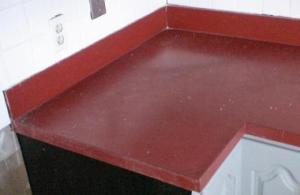Over time, laminate countertops become marred, scratched, dull or just outdated, as shown in Figure 1. If replacing your laminate countertops is not in your budget, you may want to consider painting them.

Figure 1 - Outdated laminate countertop
Painting laminate used to be a difficult if not impossible project. The biggest problem being that the paint would not properly adhere to the surface of the laminate primarily due to its high gloss.
New "bonding" primers have been developed which will adhere to the laminate surface and provide a strong base for the application of finished paints and sealers.
Laminate Countertop Painting Steps:
- Remove everything, small appliances, knife blocks, cutting boards, etc. from on top of the countertop.
- Remove the sink and the faucet.
- Remove any caulking between the laminate countertop and walls or cabinets.
- Clean the countertop.
- Inspect the surface of the countertop.
- Apply the bonding primer.
- Apply the finish coat of paint.
- Apply a sealer.
It is important that the entire laminate countertop is painted and that requires that you paint under the rim of the sink and under the base of the faucet.
This is best accomplished with the use of a small scraper or razor blade knife. Ensure that all remnants of the caulking has been removed. Silicon caulks have a tendency to leave a very thin film even after they have been removed.
This is a very critical step and often not undertaken properly. Even the best bonding primers will not adhere to any grease, grime, old paint, mildew or dirt. One of the best cleaning of a laminate countertop is accomplished with the use of a strong ammonia based solution or cleaner.
Selection of ammonia based cleaners
Clean the countertop at least twice and then rinse with clean water. Use a scrub brush if necessary, light scratch marks will be covered by the bonding sealer.
When using ammonia based cleaners it is always wise to wear rubber gloves and some form of safety glasses or goggles.
Always follow the bonding primer manufacturer's instructions for surface preparation.
If there are any areas of the laminate countertop that are chipped or gouged, repair the surface using a quality spackling compound and sand the repair so that it is level and smooth.
Follow the manufacturer's instructions for the proper application of the bonding primer. Most bonding primers can be applied using brushes, rollers or paint sprayers. One coat should be sufficient. Be diligent at the corners as the paint will have a tendency to build-up and or create drip lines.
Follow the bonding paint manufacturer's instructions (step 6) with respect to drying times before application of the finish coat of paint.
One coat should be sufficient, however, you should perform a close inspection to determine if a second finish coat is required. Follow the finishing paint manufacturer's instructions for application and drying times between coats.
It is important that the finishing coats of paint be protected with a water based sealer. I recommend that at minimum three coats of sealer should be used on kitchen countertops and a minimum of two on bathroom countertops.
